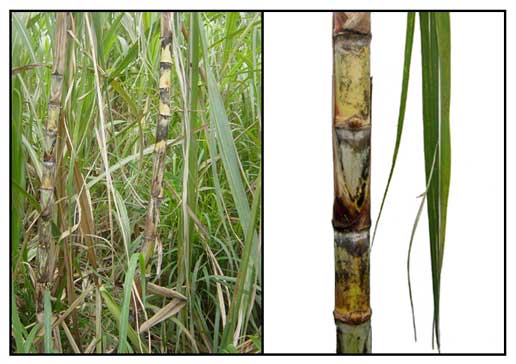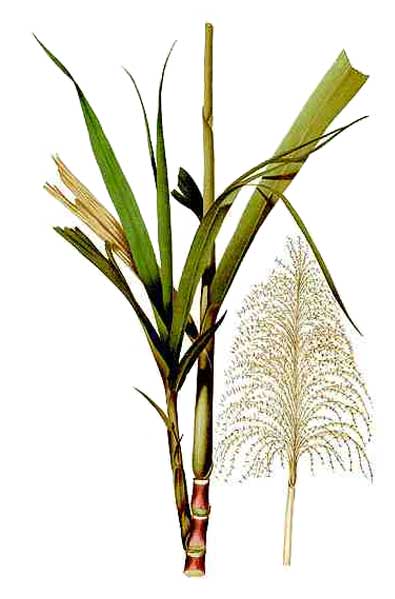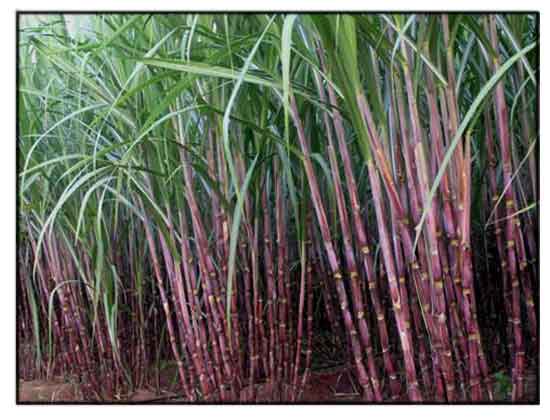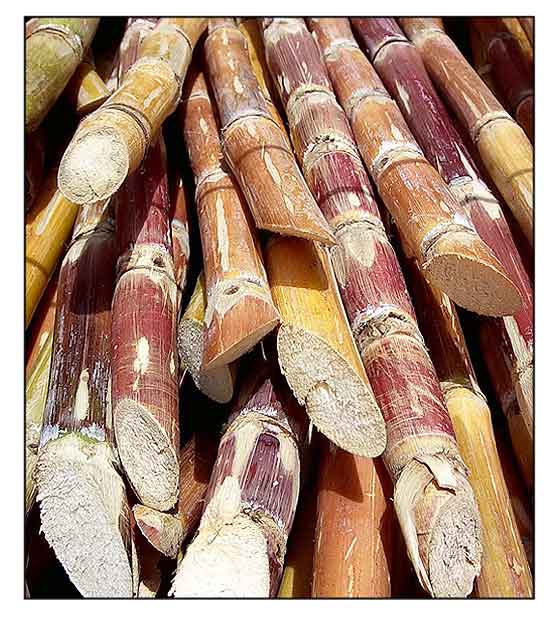
 Gen info Gen info
- Saccharum is a genus of tall perennial plants of the broomsedge tribe within the grass family. The genus includes the sugarcanes. (44)
- Saccharum officinarum is one of the most productive and most intensely cultivated kinds of sugarcane. It can interbreed with other sugarcane species, such as S. sinense and S. barberi. About 70% of sugar worldwide comes from S. officinarum and hybrids using this species.
- Etymology: The genus epithet Saccharum derives from Greek saccharon, meaning sugar or sweet juice, referring to the sugarcane genus.
-
Sugar cane is known for its economic value, producing ca. 70% of the world's sugar. Although the primary product is refined sugar, it is also source of various by-products including sugarcane juice, brown sugar, bagasse, molasses, straw, and press mud obtained in unrefined form during processing. (see study below) (28)
Botany
• Tubo is a large, coarse and
erect grass. Stems are solid, polished, green, yellow
or purplish, attaining a height of 1.5 to 4 meters, 2 to 5 centimeters thick, with
long and short internodes. Leaves are very large and broad, with blades 0.9 to 1.25 meters
long and 4 to 5 centimeters wide. Panicles are very large, white, drooping and terminal,
40 to 80 centimeters long; branches up to 35 centimeters long. Spikelets are very numerous,
1-flowered, about 3 millimeters long, with surrounding white villous hairs about
twice as long as the spikelets.
• Growth form: Tall clumping grass which can grow up to 6 m tall. Foliage: Leaves are arching and linear or lanceolate (about 70 – 150 cm long, 3 – 6 cm wide). Leaves are large with conspicuous mid rib and sharply toothed leaf margin. Leaf sheath is loose mostly glabrous while being slightly hairy at the mouth. Ligule possesses small hairs too. Stems: Stems occur in culms and are about 3 – 6 m tall, 20 – 45 mm in diameter. Culms are solid, juicy, and high in sugar content. Culms are jointed at nodes and have about 20 – 40 nodes. Internodes are often swollen and coloured. Flowers: Flowers are plume-like and usually whitish grey. Panicle is large (50 – 100 cm long), often hairless but pilose at nodes. Fruit: Seed is oblong and small (about 1.5 mm long). (40)
Distribution
- Introduced, naturalized.
- Cultivated
throughout the Philippines, very extensively in some islands and provinces.
- One of the major crops of the Archipelago.
- Native range is New Guinea.
(10)
- Widely introduced. Grows primarily in seasonally dry tropical biome.
 Constituents Constituents
- Sucrose is the product
of the sugar cane juice.
- Sugarcane wax is a whitish to dark-yellow powdery deposit n the surface of stalks and leaves
which appears as a cuticle layer. (11)
- Refined sugar is the primary product of sugarcane juice, but processing yields various other valuable products in unrefined form i.e., brown sugar, molasses, and jaggery. (11)
- Studies of sugarcane wax, juice, and leaves have yielded the presence of various fatty acid, alcohol, phytosterols, higher terpenoids, flavonoids, glycosides and phenolic acids. (11)
- Proximate analysis of sugarcane pulp yielded high amount of moisture (71.91 ± 0.05%), low dry matter (28.09%) consisting of carbohydrate (58.55 ± 0.04 g/100g), fiber (29.88 g/100g), ash (6.69 g/100g) and some mineral elements. (12)
- Phytochemica analysis of sugarcane pulp yielded alkaloids (8.07 ± 0.04 µg/100 g), saponins(5.57 ± 0.01 µg/100g) and flavonoids (1.52 ± 0.02 µg/100g), along with mineral elements magnesium, potassium, calcium and others in trace amounts. (12)
- Phytochemical screening of aqueous ethanol extract yielded saponins, tannins, flavonoids, and reducing sugars. (14)
- Phytochemical analysis of ethyl acetate extract of Brazilian hybrids yielded ß-carotene (1), steroids steroids sitosterol (2), stigmasterol (3) and campesterol (4), α-tocopherol (5), vanillic acid (6), ferulic acids (7), tricin (5,7,4-trihydroxy-3,5-dimethoxyflavone) (8), sitosterol glucoside (9), p-hydroxycinnamic (10),and p-hydroxybenzoic (11). (see study below) (21)
- UPLC/MS study led to identification of 42 metabolites, including nine flavonoids, nine fatty acids, and two sterols. C/O flavone glycosides were the main subclasses detected, with trici-7-O-deoxyhexosyl glucuronide detected in sugarcane and molasses for the first time. GC/MS analysis showed disaccharides as predominant species in sugarcane juice and molasses, with sucrose accounting for 66% and 59%, respectively, by mass of all identified metabolites. Molasses showed higher total phenolic content (TPC 196 mg GAE/100 g extract) compared to sugarcane at 93 mg GAE/100g extract. (30)
- D-003 is a mixture of high aliphatic acids isolated from sugarcane wax. The main component is octacosanoic acid, followed by triacontanoic,, dotriacontanoic and tetracontanoic acids. Other minor component acids are hexacosanoic, heptacosanoic, nonacosanoic, hentriacontanoic, tritriacontanoic, pentatriacontanoic and hexacotriacontanoic acids. (see study below) (32)
- Nutritive value of Sugarcane juice per serving (28.35gm): Energy 111.13KJ (26.56 KCal), carbohydrates 27.51 gm, protein 0.27 gm; calcium 11.23 mg (1%), iron 0.37 mg (3%), potassium 41.96 mg (1%), sodium 17.01 mg (1%). (Nutrient Information: Esha Research) (34)
Properties
- Crystals are odorless and sweet.
-
Considered antidote, antiseptic, bactericidal, cardiotonic,
demulcent, diuretic, emollient, cooling, laxative, stimulant.
- Studies have suggested immunostimulatory, prokinetic, hypoglycemic, antioxidant, steroidogenic, antimicrobial, hypolipidemic, hepatoprotective, anticancer, diuretic, antiurolithiatic, anticoccidial,
α-amylase and a-glucosidase inhibitory, hypocholesterolemic, antiulcerogenic, analgesic properties.
Parts used
Roots, leaves, juice.
 Uses Uses
Edibility / Nutritional
- Largely used
for preserving
meat and fruit.
- In India, sugarcane juice is known as a nutritional drink.
- In Nigeria, stem pulp is widely consumed as a snack for its sugar content.
- Suitable for use as rehydration and functional food plant. (12)
Folkloric
- Refined sugar has been used
for fevers, lack of secretion, dry coughs.
- Molasses is used as a laxative.
- Sugar is applied to wounds, ulcers, boils, and inflamed eyes.
- Leaf ash used to treat sore eyes. Stem juice used for sore throats, snake bites, and wounds from poison arrows. (13)
- Pulped sugar used to dress wounds; the cane used for splinting broken
bones.
- In Mexico used to relieve coughs.
- Malay women use it in childbirth.
- Decoction of root used for whooping cough.
- In India, plant juices used for abdominal
tumors.
- In Cote-d'-Ivoire, leaf decoction used for hypertension. (5)
- In India, used in the treatment of jaundice, hemorrhage, dysuria, and various urinary diseases. (11)
- In Sri Lanka, leaf decoction taken for cough. Fresh stem juice with crushed ginger given for stomachaches in children. Treacle used as laxative. (18)
- In Sindh medicine, sugarcane dissolved in water or mixed with milk is applied to affected areas of hand burn. Paste of S. officinarum and Citrus limonum mixed with Cocos nucifera oil is applied to scalp for treatment of dandruff. Paste of S. officinarum and Triticum aestivum applied for wound healing. Paste of sugarcane and jaggery in oil used for wound healing. Paste of sugarcane and butter applied to areas of psoriasis. (22)
- In Ghana, sugarcane is boiled with fruit peels of Anonas comosus and leaves of Azadirachta indica and the decoction drunk three times daily for treatment of malaria. (25)
- in Ogbomoso, SW Nigeria, juice used for treatment of diabetes. (26) In Ibibio, Nigeria, used for the treatment of malaria and gastrointestinal disorders. (41)
Others
- Products: Although the primary product is refined sugar, it is also source of various by-products including sugarcane juice, brown sugar, bagasse, molasses, straw, and press mud obtained in unrefined form during processing. (see study below: 28)
-
Wax: Used in the production of furniture, shoes, leather polishes, and waxed paper. (13)
- Alcohol / Fuel: Stem sap used for making alcohol and used as fuel. (13)
- Fiber: Stems are source of fiber for making paper. (13)
- Residue: Bagasse residue after extraction of sugar used for making fiberboard, paper pulp, furfural and cellulose. (13)
- Agroforestry / Antimalarial: Phosphorus input from sugar cane cultivation in northern Belize and its effect on malaria transmission by changing vegetation structure and composition of wetlands and associated larval habitats was studied. Results indicated marshes in proximity to agricultural fields are conducive for Typha growth, providing habitat for more efficient malaria vector. (29)
Studies
•
Immunostimulating Effect: The
phagocytic activity of peripheral blood leukocytes in chickens increased
significantly when orally administered sugar cane extracts, with higher
antibody responses and delayed type hypersensitivity responses. (1)
•
Prokinetic Effect: S officinarum was one of seven
known herbs in a polyherbal formulation. Study showed increased gastric
emptying and suggests a potential for use as a gastrointestinal prokinetic
to improve gastrointestinal motility. (3)
•
Hypoglycemic Effect: Study reports the hypoglycemic
effect of juice from sugar cane stalks. The isolated constituent, saccharin,
provided a transient reduction of blood glucose. The transient hypoglycemic
effect of complex polysaccharides is suggested to be possibly from increased
glucose utilization in the liver and peripheral tissues. (4)
• Phytochemicals / Antioxidant: Study of sugarcane leaves yielded luteolin-8-C (rhamnosylglucoside), with radical scavenging activity. The juice yielded flavones diosmetin-8-C-glucoside, vitrexin, schaftoside, isoschaftoside and 4',5'-dimethyl-luteolin-8-C glucoside. Its content of flavonoids suggest a potential for sugarcane as a dietary source of natural antioxidants. (6)
• Steroidogenesis / Testosterone Effect: Study investigated the effect of sugar cane (S. officinarum) molasses on steroidogenesis in testis cell culture. Results showed low concentrations of molasses increase testosterone secretion. Study suggests molasses may be a potential diet supplement to increase testosterone levels. (7)
• Optimization of Cytochrome C Production: Comparative study of Manihot Esculenta and Saccharum officinarum showed S. officinarum to be a better optimizer for cytochrome C production. Sugarcane had the higher rate of carbohydrate yield compared to Cassava in terms of inoculum volume with a difference of 5.57%. (8)
• Sugarcane wax: Sugarcane wax is a whitish to dark-yellow powdery deposit n the surface of stalks and leaves
which appears as a cuticle layer. It has widespread industrial applications, including cosmetic and pharmaceutical uses. It is a potential substitute for the expensive carnauba wax. The wax if a commercial source of long chain fatty alcohols, acids, esters, aldehydes and ketones. (11)
• Antimicrobial: Sugarcane extract showed highest growth inhibition against Staphylococcus aureus (8.67-24.00 mm) among the bacterial isolates and C. albicans (6.00-14.00 mm) for fungal isolates studied. (see constituents above) (12) Aqueous ethanol extract of bark showed inhibitory effect on gram negative bacteria E. coli and P. aeruginosa. (see constituents above) (14)
• Effect on Gonadal Integrity / Peel: Study evaluated the effects of an ethanolic extract of S. officinarum peel on hematological and histopathological parameters of testes and ovaries of albino Wistar rats. Results showed reduction in body weights, packed red blood cell volume, white blood cells, platelets, hemoglobin, and proliferation of ovarian tissues. Testes integrity was relatively intact. Adverse effects of the extract on ovary was evidenced by remarkable atretic ovarian follicle with loose ovarian stroma formation with a net effect of reduced folliculogenesis. (15)
• Hepatoprotective / Isoniazid Toxicity / Juice: Study evaluated the effect of S. officinarum juice on oxidative liver injury due to ING in mice. Results suggest the co-administration of S. officinarum juice may reduce INH related damage. S. officinarum treated mice showed significant decrease in elevated serum parameters of ALT, AST, ALP, and total bilirubin levels. Hepatoprotection was attributed to phytoconstituents, especially flavonoids and anthocyanins with strong antioxidant properties which can provide hepatoprotection against oxidative liver injury cased by INH. (16)
• Antidiabetic / Hypolipidemic / Antioxidant / Leaves: Study evaluated the antidiabetic and antioxidant activities of aqueous extracts of Morinda lucida and Saccharum officinarum leaves in alloxan induced diabetic rats. Results showed significant reduction (p<0.001) in fasting blood glucose of diabetic rats with the plant extracts, both separately or with the extract mixture. There was also a significant decrease in total cholesterol and LDL. Activities of SOD (superoxide dismutase) was significantly increased along with a significant reduction of malondialdehyde. (17)
• Hypocholesterolemic: Study evaluated crude extracts of sugarcane and gumamela for effect in decreasing the LDL--C level and increasing HDL-C in cholesterol induced rabbits. The crude extracts and a synthetic drug showed significant reduction in LDL-C levels, with the synthetic drug showing the best result. The effect on HDL-C was not statistically significant compared to the control group. (19)
• Anticancer / MCF-7 Cancer Cell Line / Leaves: Study of Saccharum officinarum leaves showed good percentage of anticancer activity on MCF-7 breast cancer cell line. The anticancer activity was attributed to the flavonoid and tannin contents. (20)
• Anticancer / Phenolic Compounds / Tricin / Brazilian Hybrids: Study reported on the cytotoxic activity of mid-polarity sugarcane extracts from Brazilian hybrids against human cancer cell lines. Phytochemical analysis isolated steroids, sitosterol, stigmasterol and campesterol, phenolic acids p-hydroxybenzoic, p-hydroxycinnamic, vanillic and ferulic acid, terpenoids α-tocopherol and ß-carotene and a novel substance, the flavonoid aglycone tricin. The large amount of phenolic acids and flavonoid tricin may explain the cytostatic activity. There is also evidence that tricin has chemopreventive activity, as observed in intestinal carcinogenesis models in mice (Cai et al. 2005). (see constituents above) (21)
• Diuretic / Antiurolithiatic
/ Leaves: Study evaluated an ethanolic leaf extract of dried leaves of Saccharum officinarum for diuretic and antiurolithiatic activities. Treatment with S. officinarum leaf extract at 200 and 400 mg/kg p.o. showed diuretic effect as evidenced by significantly increased urine volume and antiurolithiatic effect by decrease in elevated calcium, phosphate, oxalate and creatinine concentrations in the urine. (23)
• Anticoccidial / Eimeria Oocysts: Study evaluated an aqueous methanolic extract of S. officinarum on sporulation and morphology of oocysts of four Eimeria species of poultry. Results showed anticoccidial activity of the extract against all Eimeria species as evidenced by dose dependent inhibition of oocyst sporulation. (24)
• Silver Nanoparticles
/ Antimicrobial / Leaves: Study reports on the rapid, cost effective and eco-friendly synthesis of silver nanoparticles using fresh leaves of S. officinarum. The AgNPs showed antibacterial activity against multiple drug resistant hospital isolates of E. coli, S. aureus, P. mirabilis and hospital isolates of S. typhi, K. pneumonia, and E. faecalis. The silver nanoparticles also exhibited synergistic effect with antibiotics against MDR hospital isolates. (27)
• Pharmacologic Activities / By-Product Potential / Review: Review discusses the pharmacological activities of sugarcane and its by-products and potential for maximizing benefits as valuable medicinal products and new venues for the sugar cane industry. Molasses can be utilized in the production of ethanol and biogas. Sugarcane wax is a rich source of sterols and policosanols, widely used in many cosmetic and medical products as alternative to the pricey carnauba wax. The residue after extraction of sugar from the rind, which is regarded as rejected material, is a rich source of bioactive phytochemicals including flavonoids, polyphenols, and phytosterols. Roots and stems have potential for many medical applications. The remaining biomass, residual after sugar and bioethanol production, can be used for bioelectricity generation or second-generation of ethanol. Sugarcane bagasse and straw residues can be a valuable source of bioenergy via use of novel high-pressure boilers. Scientific studies have move traditional assumptions into use in medicinal applications. (28)
• α-Amylase and α-Glucosidase Inhibitory / Antioxidant / Juice and Molasses: Study of extracts should inhibition of α-amylase and α-glucosidase, suggesting possible antihyperglycemic effect. Molasses showed higher total phenolic content compared to sugarcane juice, and suggests a new source of natural antioxidants for functional foods. (see constituents above) (30)
• Hypocholesterolemic / Mature Leaves: Study evaluated the hypocholesterolemic properties of mature leaf of sugarcane plant using hypercholesterolemia-induced rats. Treatment with mature leaf extract f S. officinarum significantly lowered cholesterol levels, with percent reduction comparable to effects of synthetic drug, Fluvastatin. (31)
• D-003 / Forgotten Lipid Lowering Agent / Wax / Review: D-003 is a mixture of high aliphatic primary acids purified from sugarcane (S. officinarum) wax. It showed promising hypocholesterolemic effects in both animal and human studies. It significantly lowered total cholesterol (TC) and LDL-C, and increased HDL-C, and showed a favorable safety profile. On fibroblast culture, D-003 showed dose-dependent inhibition of cholesterol biosynthesis, revealing inhibition of biosynthesis at a step between acetate consumption and mevalonate generation. It did not show any direct effect on activity of HMG-CoA reductase when added to the incubation period. It does not affect TG (triglyceride) values. However, when combined with statins, TG were significantly lowered. D-003 showed a favorable safety profile and did not affect any safety indicator. Current data may not specify the most effective dose, but 5 mg/day sees to be minimal effective dose. (see constituents above) (32)
• Hepatoprotective / Paracetamol-Induced Toxicity / Juice: Study evaluated the protective effect of S. officinarum juice in acute liver toxicity with paracetamol in Wistar albino rats. Results showed fresh juice at 20 ml/kbw showed dose dependent hepatoprotective effect against PCM induced hepatotoxicity, restoring serum enzyme levels to normal. Effect was comparable to standard Clofibrate. (33)
• Anticancer / Anthocyanin / Peel: The sugarcane peel is a renewable raw material rich in different molecular species of antioxidant. The anticancer activity of its peel has been reported in literature. Study evaluated sugarcane peels for anticancer properties, antioxidant and antiproliferative activities, and anthocyanin extraction. The anthocyanin and phenolic content were found high in sugarcane peel. Antiproliferative activity by cytotoxicity assay showed 51.2% inhibition of HT29 cell line at concentration of 0.625 µg/ml. (35)
• Amelioration of Cognitive Decline in Senescence / Sugarcane Top: There have been numerous epidemiological studies on the effects of polyphenols on cognitive function. Study analyzed the polyphenolic constituents of sugarcane top and effects of its ethanolic extract (STEE) on a range of central nervous system functions invitro and invivo. Results showed orally administered STEE rescued spatial learning and memory deficit in the senescence-accelerated mouse prone 8 (SAMP8) mice, a strain with pathological feature of Alzheimer's disease. Result could be correlated with an increased number of hippocampal newborn neurons and restoration of cortical monoamine levels in STEE-fed SAMP8 mice. STEE treatment significantly regulated genes involved in neurotrophin signaling, glucose metabolism, and neural development in mice brain. In vitro results suggest STEE treatment enhances metabolic activity of neuronal cells promoting glucose metabolism with significant upregulation of genes viz., PGK1, PGAM1, PKM, and PC. STEE also stimulated proliferation of human neural stem cells (hNSCs), regulated bHLH factor expression, and induced neuronal differentiation and astrocytic process lengthening. Results suggest potential of STEE as a dietary intervention, with promising implications as novel nutraceutical for cognitive health. (36)
• Effect on Hematologic Parameters / Leaves: Study evaluated the effect of crude methanolic leaf extract of S. officinarum on some hematological parameters in albino Wistar rats. Results showed significantly increased total leucocyte count and dose-dependent neutrophilia. Other parameters showed no significant difference compared to control. Results suggest the crude ME of leaf may possess properties that stimulate neutrophil leucopoiesis. (38)
• Antioxidant / Bagasse: Bagasse is the dry pulpy residue left after extraction of juice from sugarcane. Study evaluated the antioxidant activity and phenolic compounds of sugarcane bagasse extracts. The AU17 cultivar extract showed highest phytochemical content and highest antioxidant activities by ABTS, DPPH scavenging activity and metal (FRAP, CUPRAC) reducing power. Dominant substances in the sugarcane extracts were gallic acid, p-coumaric acid, caffeic acid, quercetin, and epicatechin. (39)
• Antiulcerogenic / Leaves: Study evaluated the antiulcerogenic activity of leaf extract of Saccharum officinarum against indomethacin, ethanol, and histamine-induced ulcer models in rats. The leaf extract at doses of 170-510 mg/kg was found to exert significant (p<0.05-0.001) and dose-dependent activity against indomethacin, ethanol, and histamine induced ulcers. (41)
• Analgesic / Leaves: Sugar cane is used in traditional medicine to treat arthritis. Study evaluated an ethanolic leaf extract (170, 340, 510 mg/kg) for analgesic activity against experimentally-induced pain in mice using three standard models of pain viz., acetic acid-induced writhing, formalin-induced hind paw licking, and thermally induced pain. The median lethal dose (LD50) was estimated to be 173 g/kg. The leaf extract significantly (p<0.005-0.001) inhibited pain in all models of pain in a dose-dependent manner. Results confirm its use in traditional medicine in the treatment of pain. (42)
Toxicity concern and safety studies
• Veterinary toxicity concern: Sugarcane contains
hydrocyanic. Sugar cane is a known teratogen (causing malformation in embryos) and is known to stimulate somatic mutations (aneuploidy and polyploidy) in plants. Molasses in excess amounts,
alone or mixed with feeds, may cause diarrhea, colic, urticaria, kidney
irritation, profuse sweating and paralysis in domestic stock; horses seem more
susceptible, and 1.25 kg daily for 3 weeks has proved fatal in some. (Watt, JM and Breyer-Brandwijk, MG 1962) (45)
• Safety study / Cosmetic Review: The Expert Panel for Cosmetic Ingredient Safety assessed the safety of 4 Saccharum officinarum derived ingredients, which function in cosmetics as skin-conditioning ingredients, viz., sugarcane bagasse powder, extract, juice extract, and wax. Acute toxicity study: Animals were given doses of 50, 200, or 200 mg/kg via gavage. No deaths occurred, with no clinical observation of related toxicity. No pathological effects were found at necropsy. Subacute and chronic toxicity studies: Doses of up to 1250 mg/kg were given for 90 days. No hematological or signs of toxicity were observed. It concluded that the ingredients were safe in present practices of use and concentration described in safety assessment. Studies on wax and extract showed no carcinogenicity or genotoxicity effects. On dermal irritation and sensitization studies, the product was considered well-tolerated. The expert panel concluded bagasse powder, extract, juice extract, and wax are safe in cosmetics in present practices of use and concentration described in the safety assessment. (37)
Availability
Cultivated.
|



